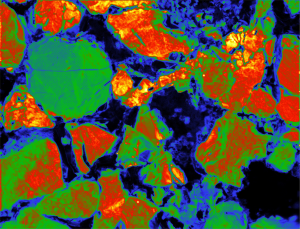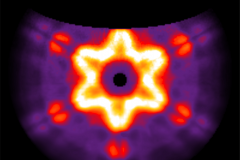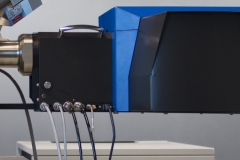阴极荧光是材料在电子束辐照下激发出的光
随着纳米级光电器件和新材料的应用越来越广泛,在纳米尺度上对光的控制也越来越重要。它为众多技术进步打开了一扇新的大门,比如对化学品的高精度探测和鉴定,提高发光装置和感光装置的性能,提高太阳能电池的能效等。
在纳米尺度上对光学属性的表征相当有挑战性。其原因是光学技术总是被光的衍射极限所束缚。所以阴极荧光技术越来越流行,成为一种对材料和系统表征上具有广泛应用的新技术。
高效率的阴极荧光
SPARC是高性能的阴极发光探测器。SPARC可以与任意扫描电子显微镜兼容,且操作流程非常简便。它的高灵敏度和易用性将阴极发光应用提高到了新的高度。凭借独一无二的高精度镜台,SPARC开辟了如电子束诱导纳米光子学的新的研究途径。 SPARC不仅可在纳米尺度上实现快速灵敏进行材料表征,也是最早具有角度分辨模式并且具有独一无二时间分辨模式的阴极发光探测器。它是阴极发光探测系统中的最佳选择。
模块化设计
SPARC的开源性软件以及模块化设计给您提供了高度的实验自由。与此同时,SPARC系统兼具后续可扩展性。它独特的模块设计保证了系统的可靠的整合性能。
无与伦比的灵敏度
独特精确的自动校准程序为您提供了最好的用户体验。具有超级光滑的表面的铝制抛物面收集镜极大地提高了光子产量并实现了高质量的角度分辨成像。
可重复性
为了确保系统的最佳性能,收集镜安装在了一个高精度电动台上。它可在实验之间的重复进行校准,帮助您多次比较不同的测量结果。
光谱模式
当SPARC系统用于光谱模式时,来自镜子的光聚焦在连接到Czerny-Turner光谱仪的狭缝或光纤上。通过使用不同的成像检测器,您可以检测在200-1600nm范围的光谱。 最后的空间分辨高光谱图像是通过扫描样品上的电子束而产生的。
角度分辨模式
可以提供非常独特的阴极发光角度分辨解析图像。与将光信号聚集在光纤或狭窄开口不同,在这个成像模式下,镜子的图像会投影到成像相机上。这能让您检测到发射光的方向(动量光谱)。在这种模式下,调整使用滤光片转轮来选择需要的波长。
阴极发光时间分辨成像
LAB Cube是SPARC阴极发光探测器的时间分辨模块。它独特的g(2)成像和 lifetime成像使之成为了阴极发光领域的焦点。阴极发光的时间分辨成像对众多应用领域有着重要的作用。这其中包括用于光电子学的半导体以及用于量子信息处理和传感的单光子发射器系统。
| FEATURES |
| High Spatial Resolution |
| Modular and User Specific Spectral Imaging |
| Angle Resolved CathodoLuminescence |
| Polarisation Mode |
| Camera and PMT CathodoLuminescence |
| APPLICATIONS |
|
Geology Cathodoluminescence imaging is particularly useful for providing mineralogical information. The color and intensity of the emitted light gives insight into processes as crystal growth, replacement, deformation, provenance, and defect structures and can be used to fingerprint minerals down to |
|
Nano Photonics The SPARC offers a very powerful method to study optical phenomena at the nanoscale and to understand how light couples to matter in a fundamental way. It is also a useful tool for improving the performance of optoelectronic devices, because the light-emission maps created with the technique reflect the local density of electromagnetic states, a quantity that determines how well light couples to matter and vice versa (1). |
|
Spectral Mode When the SPARC system is used in spectral mode, the light from the mirror is focused on a grating, as part of a Czerny-Turner spectrograph. A silicon detector is connected to the spectrograph resulting in optimized detection over the range of 400-900 nm. By scanning the e-beam across the sample,a hyperspectral image is made. |
|
Angular Mode The SPARC provides the unique option to acquire angleresolved images. Instead of focusing the light signal on a grating, an image of the mirror is projected onto an imaging camera. This allows for the detection of the directionality of the emitted light; also known as momentum spectroscopy. In this mode a filter wheel is used to spectrally distinguish the different emission wavelengths. |
|
Cathodoluminescence color imaging Adding a PMT to your setup allows to do easy and fast acquisition of photons and further reducing the measurement time to acquire CL colour images. By adding a monochromator this can be either done for all photons, or for individual wavelengths. This will also enhance the field of view. |
|
Sample Size |
25 x 46 cm |
|
Resolution (Spectral) |
0.2nm |
|
Resolution (Angular) |
< 10 mrad |
|
Camera |
sCMOS |
|
Efficiency |
87% collection efficiency from a Lambertian source |
|
Spectral range |
Modular <400nm to >900nm |
|
CE certified |
Yes |
|
RoHS compliant |
Yes |













